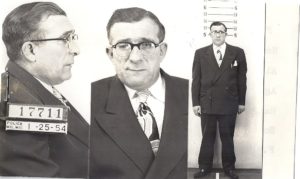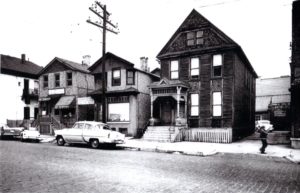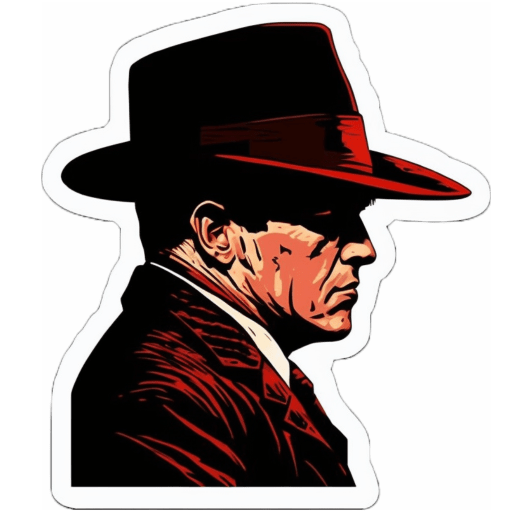Jack Enea
Jack Enea was a member of the Milwaukee Mafia, and was considered to be one of the “Young Turks”, which also included John DiTrapani and Frank LaGalbo, who had angled to take over leadership from Milwaukee Mafia boss John Alioto. Under Alioto’s rule, the muscling of gamblers and legitimate businesses stopped, but internal dissent continued. DiTrapani spread the word that he would pay for “hits” in order to get the leadership role. This would lead to his eventual death, Enea’s death, and cause LaGalbo to lose stature and to transfer his mafia membership.
On November 29, 1955, Jack Enea was murdered. His bullet-riddled body was found in a ditch in rural Waukesha County by a mail carrier. Enea had seven bullets from a .38 in him, two of those lodged in his spine. No one has been held accountable for his death.
Family
Giacomo “Jack” Enea was born in Chicago on September 4, 1908 to Giuseppe “Joseph” and Vita (Carollo) Enea. His parents were from Bagheria, Palermo, Sicily, Italy. Joseph arrived in the US in 1903, and Vita arrived in 1905. The Eneas had eight children, and Jack was the third oldest, and first to be born in the United States.

Jack Enea
Jack married Jennie Carbone, daughter of Black Hand letter writer Ross Carbone. Jennie and Jack had three children: Joseph, Russell, and Vivian.
Enea’s son Joseph married Frank LaGalbo’s sister Frances. Joseph became a bartender in various night clubs and taverns owned and operated by mob boss Frank Balistrieri. Both Joseph and his brother Russell will appear in future podcast episodes.
Mafia Connections
Jack’s father, Joseph, and his paternal uncle, Michelangelo were members of the mafia. Additionally, he was tied by marriage to such members as Joseph “Joe Pizza Pie” Aiello in Madison, Pete Gargano in Waukegan and Andrew DiSalvo in Racine.
A Life of Crime
His earliest days were spent bootlegging, and he was arrested in Milwaukee in June 1931 for violating Prohibition. He was fined $250 and sentenced to ten months.
Enea turned to robbery and started a gang called the Collegiate Boys. Its membership was flexible, but seemed to have a few core members, with Enea as leader. No business was safe. The Wisconsin Gas and Electric office in Cudahy was held up for $500 in July 1935. A customer was pushed around as the register was robbed. The cashier later identified Enea as one of the men involved.
In November 1935, Enea, Louis Maniaci, 25, John D’Amore, 35, Anthony Clementi, 24, and Dominic Picciurro were arrested for robbing the tavern of Ed Burroughs in Pewaukee. After ordering beers, the gang turned violent. Bartender Barney Kolander and two patrons were backed against a wall at gunpoint. Kolander gave the men a key to a cabinet where two broken gambling devices were. The men stole a slot machine and $50 worth of nickels and quarters. They escaped in a truck and a car, but were chased by police down Bluemound Road and forced into the ditch. They tossed a pistol out the window as they drove, but it was later recovered. One of the men confessed to being part of a gang responsible for slot machines thefts throughout the greater Milwaukee area.
On November 13, 1935, police arrested Tom Lupo, suspected of being in the same gang as the men who robbed Ed Burroughs. LoBue was identified by William Kliebe as one of the men who robbed his father’s tavern, the Cat and Fiddle in Waukesha County, and knocked out several of his teeth. The bandits had tried to steal two slot machines.
Louis Fazio was arrested in Waukesha on November 20 for assaulting Willard Kliebe, proprietor of the Cat and Fiddle, and was released on $3,500 bond. When the case went to court, Fazio pleaded guilty and was sentenced to six months hard labor.
Tony Clementi had his preliminary hearing on November 25. Oscar Kolander testified to giving the robbers the keys to a cabinet containing two broken slot machines after being threatened. The state also presented the discarded gun and six shells. After the state presented its case, defense attorneys waived preliminary hearings for Enea, Picciurro, D’Amore and Maniaci. They were bound over for trial and bond was set at $3,500 each. Fruit vendor Harry D’Angelo, an associate of Picciurro’s with a history of assault and rape, was in court the same day for carrying a concealed weapon.
A tavern in Racine County was robbed in December 1935 by the Collegiate Boys, out on bail. Four men entered the tavern and said, “We’re the collegiate boys. We’re just trying to work our way through college.” They received a small amount of cash, merchandise and a radio. The same words were used in robberies in Milwaukee, Waukesha, Kenosha and Jefferson counties. Soon, four men would be named as involved in this robbery: not surprisingly the suspects were Jack Enea, Louis Maniaci, Dominic Picciurro and John D’Amore.
On March 2, 1936, defense attorney Mario Megna brought up a new argument — because Ed Burroughs possessed his slot machines illegally, it would not be a crime to take or destroy them, as they had no value. This was rejected by the judge. “We are not trying the machines,” he said.
A verdict was returned on the evening of March 4, and was read in open court on March 5 — all five defendants were guilty. Enea and Picciurro were convicted in Waukesha County on March 16 for unarmed assault, theft and larceny stemming from their Pewaukee incident and were sentenced to eight years in Waupun State Prison. Clementi was given four years while Maniaci and D’Amore each received five years. Enea and D’Amore had charges dismissed regarding the Racine County tavern holdup when witnesses could not identify them.
This did not end the defense’s clever legal argument. They petitioned the Wisconsin Supreme Court in August 1936, again arguing that the men could not be held for grand larceny because the slot machines could only be considered junk. Though they were given a value of $450 each in court, this would be an unlawful price seeing as slot machines were illegal. The argument was again rejected.
Several years were spent in and out of Waupun State Prison. In January 1938, Governor LaFollette reduced Enea’s eight year sentence to six, and he was paroled in May 1939. He had one year of freedom before again being arrested, this time in December 1940 for embezzlement. Enea was convicted in May 1941 and sentenced to four more years, but paroled after only serving two.
Again making it only about a year, Enea was arrested by the Secret Service in February 1944 for the illegal transfer of gas coupons. He was handed over to US Marshals and held under $2500 bail. Chicago gas station owner Sam Brancato was picked up with him. They were suspected of having coupons for as much as 1,000,000 gallons of gasoline. Enea was apparently released.
His final known criminal act came four years later when he was arrested in May 1948 for being keeper of a gambling house. An officer went to the second floor of a tavern and then signaled other cops to make a raid. Twenty men, seventeen from Milwaukee (including Enea), were arrested. Police seized two loudspeakers, two telephones, betting sheets, tickets, a pool table and a card table.
Businesses
Oregon Inn, South 2nd Street
Ervin Bolda worked for Jack Enea and Anthony Lazzaro from August through October 1954 at the Oregon Inn. On one occasion he had been drinking heavily while tending bar at the Oregon Inn and got into an argument with Enea, who threatened him with a blackjack. Bolda was struck in the head several times and his scalp was lacerated. The incident ended with apologies all around and the whole thing was forgotten. Bolda denied that any gambling took place at the Oregon Inn, but said there was “bad blood” between Enea and Lazzaro as a result of a dispute over who owned the fixtures and stock. He said he was not paid a penny for the three months he worked there and that all money coming in went immediately to outstanding bills. Bolda was promised to be repaid later but never was.
Anthony Lazzaro saw Enea at a Common Council meeting in July 1955, but they did not speak. The last time they spoke was in 1954 when Enea threatened him over the phone.
Vickey’s Tavern, 1932 West St. Paul Avenue
Next Enea operated Vickey’s Tavern, named after Enea’s 10-year old daughter Vivian.
Enea Produce Company
Enea also went into business for himself as the Enea Produce Company selling food out of his home. By 1955, he was ordering cheese and biscuits wholesale. The food was then resold to those Enea knew in the hotel, tavern and restaurant business. It may not have been hugely profitable, but it kept him in contact with all the right people.
Murdered – November 29, 1955
Enea, now 46, left his home on Jackson Street in his son’s Buick. He dropped his daughter off at school, and by 7:00 am, he pulled in to Rosy Santoro’s Clark Gas Station on North Jackson Street, and parked in the lot. Within fifteen minutes, Walter Brocca was heading south on Jackson in his Cadillac when he saw Enea’s car, backed up and entered the lot. Enea walked over and talked to Brocca, and went back to the attendant and said if anyone called for him he would be back in a little while.
Enea entered Brocca’s car and they drove east. They stopped at Snyder’s at Ogden and Farwell for coffee and stayed for fifteen or thirty minutes, where they saw Sam Clementi.
Brocca dropped Enea off at Clark Gas Station before driving away to a service station. Enea again told the attendant that if he received any calls, he would be back. He briefly spoke with a deputy sheriff across the street at a cafe. (The attendant later said that Enea appeared worried, and that he found it strange that Enea was so quiet and in deep thought because he usually is loud and talkative.)
Between roughly 9:00 to 9:30 am, Enea met with Brocca on North Van Buren where he was remodeling a pizzeria for Santo Marino. Enea was cheerful and talked about a court case involving worthless checks. Enea said he had 60 or 90 days to pay them, but had a promissory note for $6100 that he was going to turn over to Dominic Frinzi, who in turn would get the money from another attorney.
What happened next is a mystery. We jump ahead an hour…
A woman heard what sounded like gunshots in rural Waukesha around 11:00 or 11:05am. When she looked out, she saw a Plymouth station wagon.
A man drove down Hillside Road across the intersection with Plainview Road between 11:25 and 11:30am and saw a Chevrolet parked nearby. When returning a half hour later, he saw a man in work clothes at the scene, perhaps as many as seven or eight men.
Between 11:30am and noon, 5-year old Dean Friess was walking along the road to visit his grandmother when he was passed by a dark car. Dean had to move into the ditch to avoid being hit.
Mail carrier Rudy Kerstein found Enea’s body in a ditch on Plainview Road two miles northwest of Sussex (Waukesha County) around 11:50 am and went to the home of Theodore Siewert, who called the police around 12:04 pm. Enea had seven bullets from a .38 in him, two of those lodged in his spine.
The dispatcher contacted Officer Roelandts, who was at North and 124th at the time. He reached the scene at 12:22 pm. A quick check revealed that he had been beaten or shot in the back of the head. The ambulance had already been dispatched, so Roelandts radioed in for camera equipment and requested both the sheriff and undersheriff come to the scene. Enea’s body was in an 18-inch ditch on the south side of Plainview Road with his head, face down, pointed south. His head was at his ankles, smeared in blood, and his broken glasses were found under his hat. Footprints surrounded the body in the snow. Roelandts took photos of the scene and Enea’s body was taken away in the ambulance. Tire tracks showed that a car had stopped at the scene and was heading east. The marks suggested that upon leaving, the tires had been spinning.
Anthony Carmen Bruno, 41, was at Santo Marino’s tavern on East Juneau Avenue when he heard about the shooting of Enea on WRIT radio. He immediately went to Enea’s home and found Jennie Enea hysterical. She had been told about the murder by a neighbor woman.
Investigation
Joseph Enea, 23, said he had the only car in the family, but both him and his father had a set of keys. Although he did not know his father’s business associates, he believed that Jack sold cheese and canned goods out of their home. In the past year, he could not recall a time where his father visited another city or did not come home at night, nor did he think his father seemed worried or nervous lately. Joseph was employed as a bartender at the White Pub (North 3rd Street) and worked every night from 6pm until 2am. His last encounter with his father was when he (Joe) returned home from work that morning and Jack called out from the bedroom.
Walter Brocca was picked up at Santo Marino’s pizzeria and held for questioning. Brocca told the police he had never shot a gun in his life. The clothes he wore were retrieved to test for physical evidence. Police held Brocca for over sixty hours without charging him, until attorney Dominic Frinzi insisted they either charge him or let him go. Brocca volunteered to take a lie detector test if his attorney consented. Frinzi did not allow the test and no charges were filed. Frinzi filed a writ of habeas corpus against Sheriff Michael Lombardi for Walter Brocca, who he said was “illegally imprisoned and restrained of his liberty”. He was then freed.
Police obtained a search warrant for the residence on North Jackson Street. Five officers went, two stationed outside, as they searched the second floor apartment. They took with them one hat, two pairs of trousers, a trench coat, three .38 cartridges, three .32 cartridges, a box of twenty-four .22 “bird shot” cartridges, a box of twenty-nine .32 automatic cartridges, fifteen rounds of carbine ammunition and a carbine rifle clip. They were brought back to the detective bureau. With so much ammunition, where were the guns?
After the new year, a lab report returned saying all five bullets were fired from a .38 Colt. A sixth bullet came from a .38 Colt Detective Special. The tire tracks at the scene traced to a B. F. Goodrich Life Saver, Puncture Sealing, Tubeless Tire. Unfortunately, the lab was unable to determine the tire size. A coat pocket showed that Enea frequently carried a Colt Detective Special, suggesting that one of the fatal bullets came from his own gun.
At the end of the investigation, little certainty could be had on anything. Detective Glaser of the Milwaukee Police Department believed that a black Cadillac picked Enea up from former boss Sam Ferrara’s Peacock tavern on North VanBuren, where his son’s Buick was found parked. Glaser narrowed the death car down to a 1948 or 1949 Cadillac after a witness informed him that the car had fin fenders.
Theories
Two competing theories exist on why Enea was killed, both of which involved mob boss John Alioto and Joseph Sciortino. One unidentified FBI informant speculated that the killing was ordered by Alioto at the request of Sciortino. Sciortino was Enea’s brother-in-law, and owned a bakery on Van Buren Street adjacent to Alioto’s tavern. Allegedly, Enea’s goons burglarized the bakery and stole $1400. The informant believed that a black Cadillac was involved and that at least two killers were used — one was identified as John Aiello and his brother Vito Aiello was also suspected.
 Sciortino Bakery, Van Buren Street
Sciortino Bakery, Van Buren Street
Another informant said that Alioto had once tried to purchase Sciortino’s bakery, but Sciortino refused. Alioto put pressure on Enea to pressure Sciortino as they were related, and Enea resisted. Alioto then ordered Enea killed. The triggerman was allegedly Vito Aiello, who disliked Enea anyway because Enea had been the murderer of Frank Aiello.
The second theory is the more plausible one. We know that Enea, along with DiTrapani and LaGalbo, was angling to have the Young Turks take over leadership from Alioto. That Enea would resist an order from Alioto is thus more believable than the idea that he would burglarize his own family, especially when he already ran a successful tavern.
Frank LaGalbo, the third partner of the DiTrapni-Enea-LaGalbo uprising, had his life spared by appealing to friends in Chicago Heights. He was kicked out of the Milwaukee Mafia around 1955, but lived on through the 1970s as an underling of Frank LaPorte and Al Pilotto. He allegedly committed suicide after suffering a stroke in 1976.
